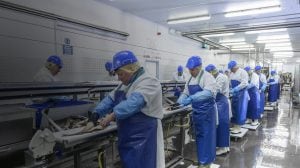June 21, 2019
Achieve safety and compliance with durable LED technology
Anyone in the food industry knows that safety and compliance are crucial, with extra scrutiny paid to keeping food safe and contamination-free. What you may not know is that one of the most effective solutions to food safety is also one of the most efficient: LED lighting technology.
“Industrial lighting consultants often can increase productivity, enhance safety and augment sanitation with minor modifications to the existing lighting system - with an eye toward economy,” says Robert W. Powitz, Ph.D., MPH of Food Safety Magazine.
Yet typically, when people think of food safety, properly washing and sanitizing food are among the first things that come to mind. While these measures are obviously important, a less direct yet equally impactful aspect is high-quality lighting. Let’s look at how LED lighting fixtures can improve safety, compliance, and your bottom line.
LED technology meets stringent food processing standards
LED technology has special characteristics that ensure food is processed in the most sanitary environment possible, and that food processing facilities pass inspection.
One of those characteristics is a high Color Rendering Index (CRI), which is the ability to see the true colors of your environment.
Upon installing LEDs with a high CRI, restaurant and food processing workers often remark that they hadn’t realized how dirty their work environment really was. The previous traditional lighting had been masking the dirt, dust, and grime. LED lighting reveals the true state of sanitation, ensuring food is processed in the cleanest environment possible.
A high CRI also allows employees to better spot mold, discoloration, and other deficiencies in foods -- problems that could otherwise lead to costly recalls.
Besides offering higher-quality light, LED technology can also improve inspection scores. A high CRI is more important than ever, with the USDA and FDA continuously tightening food processing lighting requirements; it has raised the minimum CRI requirement repeatedly over the years.
In fact, a recent article in The Lighting Center noted that many food processing managers, anticipating that this upward trend will only continue, are investing in LED lighting with the highest-available CRI in order to stay code-complaint and ensure food safety.
LED lighting protects food processing workers
Along with improving code-compliance, LED technology also increases workforce safety. That’s because many injuries in food processing work environments arise from poorly lit areas where workers are likely to trip or bump into equipment.
And while the emphasis on thoughtful lighting is typically relegated to customer-facing areas such as lobbies and outdoor spaces like parking lots, it should not be dismissed in areas where grinders, slicers, and, of course, food, are present. The lighting needs of employees are equally important and should be considered in food processing building design.
The benefit of LED lighting is that light can be customized in great detail, adjusting brightness, color, temperature and wavelength to eliminate shadows, glare, and other conditions leading to slip-and-fall and other accidents.
As just about any facility manager will tell you: an improvement to worker safety is an improvement to the company’s bottom line.
LED pays for itself in reduced maintenance and energy costs
LED lighting makes food processing facilities safer and more code-complaint, but what does it cost? LED lighting is practically maintenance-free, lasts ten times longer than traditional lighting technologies, and significantly lowers downtime and labor costs.
It also requires far less energy than traditional lighting. Paired with features such as occupancy sensors and lighting controls, LED technology ultimately reduces energy costs by up to 90%, according to The Lighting Center.
What’s more: LED technology can help curb equipment loss. Some incidents can be easily avoided with better lighting, such as tools or bolts being dropped into machinery or other accidents that harm equipment.
Finally, government programs and utility companies offer money-saving rebates to companies that switch to energy-efficient LED technology.
The result? Most food processing facilities find that LED upgrades pay for themselves within about two years.
LED shines in extreme temperatures
Perhaps the most obvious reason LED is perfect for food processing facilities is its ability to withstand the cold. Because traditional bulbs require time to warm up, employees may be tempted to leave them on all day. The warm-up time can also make facilities more hazard-prone, if the lights don’t fully illuminate in time to prevent an accident.
By contrast, low temperature LED lights instantly illuminate cold rooms and run efficiently and reliably in extreme temperatures for years.
LED technology is a wise investment for food processing facilities hoping to increase safety, compliance, and cost-savings. What’s more: they are scalable solutions that can be built upon and customized further as your company grows, without having to be replaced very often.
To learn more about how LED technology can help achieve safety, compliance, and savings for your food processing facility, visit us HERE to learn more.

